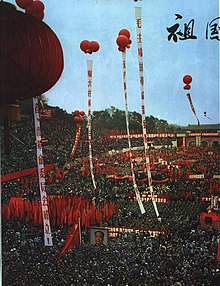
Back Massaker von Guangdong German Masacre de Guangdong Spanish Massacre de Guangdong French Massacro della Rivoluzione Culturale del Guangdong Italian Massacre da Revolução Cultural de Cantão Portuguese 文革大屠杀 (广东) Chinese
| Guangdong Cultural Revolution Massacre | |
|---|---|
| Part of the Cultural Revolution in China | |
 Illustration of the establishment of the Guangdong Revolutionary Committee (1968). | |
| Native name | 广东文革屠杀 |
| Location | Guangdong Province |
| Date | 1968 July 1968 – October 1968 |
| Target | Counter-revolutionaries, opponents of Mao Zedong thought, members of the "Five Black Categories" |
Attack type | Political persecution, politicide, politically motivated violence |
| Deaths | 1,000-8,000 (Estimated) |
| Perpetrators | Chinese Communist Party, local Revolutionary Committees |
| Motive | Reprisals against class enemies, destruction of the Four Olds and Five Black Categories |
The Guangdong Cultural Revolution Massacre (simplified Chinese: 广东文革屠杀; traditional Chinese: 廣東文革屠殺) was a series of massacres that took place in Guangdong Province of China during the Cultural Revolution.[1][2][3][4][5] There were 80 counties in Guangdong during the Cultural Revolution, and according to the 57 county annals which became available during the "Boluan Fanzheng" period, massacres occurred in 28 of the counties with six counties recording a death toll of over 1,000—the average death toll among all the 28 counties was 278.[1][2][5] The massacre in Yangjiang was the most serious, with over 2,600 deaths in Yangchun County alone.[2][4][6] In addition, massacres also occurred in some cities of Guangdong; in the capital city Guangzhou, for example, the massacre targeting the prisoners of Laogai resulted in the deaths of at least 187–197 people within a week of August 1967.[7]
Most of the Cultural Revolution massacres in Guangdong took place from July to October, 1968, and were led and organized by the provincial and local revolutionary committees.[1][2][4][5] The Guangdong massacre was among the most serious collective killings in China at the time, and was related to the Guangxi Massacre.[1][2][8][9] There were two major types of massacres in Guangdong: one type targeted members of the Five Black Categories (landlords, wealthy peasants, "bad influences/elements" and "right wingers") as well as their relatives, and the other type was related to political persecutions.[1][2] Moreover, in eastern Hainan, which was an administrative region of Guangdong Province at the time, massacres also occurred in places such as the Dan County (over 700 deaths).[4][5][10]
After the Cultural Revolution, some of the victims in the massacres were rehabilitated by the Central Committee of the Chinese Communist Party (CCP) as well as the Guangdong Provincial Committee of CCP during the Boluan Fanzheng period.[11] In January 1980, the Guangdong Revolutionary Committee was removed and the People's Government of Guangdong was re-established.[12]
- ^ a b c d e Su, Yang (2011-02-21). Collective Killings in Rural China during the Cultural Revolution. Cambridge University Press. ISBN 978-1-139-49246-1.
- ^ a b c d e f Su, Yang (2006). ""文革"中的集体屠杀: 三省研究". Modern China Studies (in Chinese).
- ^ "Brown on Su, 'Collective Killings in Rural China during the Cultural Revolution' | H-Human-Rights | H-Net". networks.h-net.org. Retrieved 2020-06-10.
- ^ a b c d Song, Yongyi. "Chronology of Mass Killings during the Chinese Cultural Revolution (1966-1976)". Sciences Po. Retrieved 2020-06-10.
- ^ a b c d Hays, Jeffrey. "CULTURAL REVOLUTION: DEATH TOLL, FIGHTING AND MASS KILLING | Facts and Details". factsanddetails.com. Retrieved 2020-06-10.
- ^ Chen, Baode; Li, Xuechao. "阳江"乱打乱杀事件"始末". Yanhuang Chunqiu (in Chinese). Archived from the original on 2020-11-25. Retrieved 2020-04-29.
- ^ Zhang, Zhishen (2014). ""文革"期间广州的"打劳改犯"事件". Renmin Wang (in Chinese). Archived from the original on 2020-11-21. Retrieved 2020-06-10.
- ^ Walder, Andrew G.; Su, Yang (2003). "The Cultural Revolution in the Countryside: Scope, Timing and Human Impact". The China Quarterly. 173 (173): 74–99. doi:10.1017/S0009443903000068. ISSN 0305-7410. JSTOR 20058959. S2CID 43671719.
- ^ Yan, Lebin. "我参与处理广西文革遗留问题". Yanhuang Chunqiu (in Chinese). Archived from the original on 2020-11-24. Retrieved 2020-06-10.
- ^ Lin, Xue (2019-10-17). 赵紫阳 · 从革命到改良 (广东篇) (in Chinese). 世界华语出版社. ISBN 978-1-940266-62-6.
- ^ Li, Shengping. "习仲勋在广东主持平反冤假错案". Yanhuang Chunqiu (in Chinese). Archived from the original on 2020-06-10. Retrieved 2020-06-10.
- ^ "[广东省历届人民代表大会历次会议大事记](1954-2008)". The Guangdong People's Congress (in Chinese). Archived from the original on 2020-11-03. Retrieved 2020-06-10.
© MMXXIII Rich X Search. We shall prevail. All rights reserved. Rich X Search